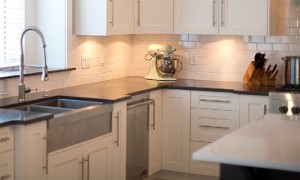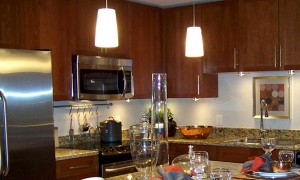Modern households find many creative uses for available counter space: arts and crafts projects; work or homework completion; and the best place to leave keys, library books, lunch boxes, and junk mail. Also, countertops must be designed to handle food preparation and add character to your kitchen. An array of different materials serve this purpose, including stone, tile, solid surface, stainless steel, wood, and laminate.
Philadelphia homes built about fifty to sixty years ago in what is commonly known as the mid-century modern style often feature a wooden butcher-block countertop. Today, this countertop style is resurging in popularity due to its practicality and natural look. Philly-area chef Marc Vetri, whose home is featured on houzz.com, recently incorporated the wood-style countertop into his own kitchen.
Butcher Block for the Serious Chef
When comparing butcher block to granite—another popular choice in remodeled kitchens—remember that both materials have distinct advantages and different visual styles. Many serious chefs prefer a butcher-block countertop because the wood surface is scratch resistant and does not dull knives. Also, food can be chopped and rolled directly on the surface. Rather than storing a large wooden cutting board, butcher block is built directly into a kitchen work space, an island, or even an entire counter. End grain butcher block is the most durable, but edge grain also works well in a residential kitchen.
By contrast, a granite countertop offers a smooth, impervious surface. Bakers appreciate the uniformly flat, unyielding stone for kneading and rolling out dough. For those working in a busy kitchen, the impressive heat resistance is also an important quality, especially for those who have ever scorched a laminate countertop with a hot baking sheet.
Cleaning and Sanitation
Butcher-block countertops are more susceptible to staining than granite, but unlike granite, a butcher-block countertop can easily be repaired. The quick fix for stains involves sanding and refinishing the wood. Some manufacturers of butcher blocks add a food-safe finish on top of the wood. In this case, the finish must be re-applied. Mineral oil is also recommended for butcher-block countertops to maintain and protect the natural wood finish.
As for cleaning, both butcher block and granite are easily cleaned using mild soap and water. The butcher block surface is porous, so strong-smelling foods like onions can penetrate if the counter is not immediately cleaned. Overall, sanitation using a bleach and water solution is recommended for butcher-block countertops because, unlike loose cutting boards, you cannot sterilize a butcher-block countertop in a dishwasher. For those looking to do some serious food prep involving raw meats and pungent food materials, a butcher-block countertop certified by the National Sanitation Foundation (NSF) is recommended.
Modern Options Help You Achieve the Retro Look of Butcher Block
If you aren’t a serious cook but like the natural look of butcher block, consider installing finished wood countertops with a stain-proof coating. Using knives directly on the coated wood countertop will not be possible, but you will still create a vintage kitchen look without needing to worry about maintenance and sanitation issues.
Traditionally, butcher block is maple wood, but newer counters are constructed from eucalyptus, cherry, oak, or teak. Because wood tends to warp when subjected to repeated water spills, you may wish to install butcher block on a separate kitchen island rather than around your sink area. You may also want to vary your countertop styles by using another durable material—such as laminate, tile, or granite—in places where you will not be chopping, slicing, and dicing.
Photo Source: Flickr
[cf]skyword_tracking_tag[/cf]







Granite countertops are still the number one choice in the Austin Tx area….remembering the wood butcher block countertops we had as a child and the condition they became, stains, cut marks and odors, I would not recommend them.
I have a large butcher block counter top and the stains and cut marks are a bonus IMO. They give it an authentic distressed look. As for odors? I have never had that issue with our side grained block.
If you aren’t a serious cook but like the natural look of butcher block, consider installing finished wood countertops with a stain-proof coating.
What can you use for a stain proof coating??????